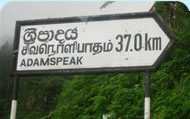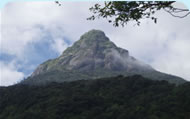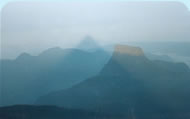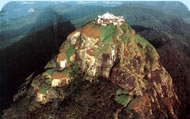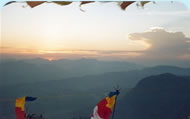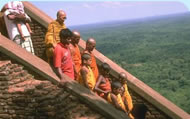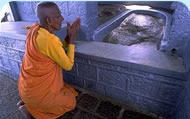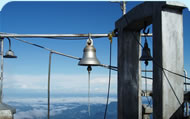Adam's Peak: Its History
|
Buddhist devotees who climb the Peak regard God Maha Sumana Saman as their benevolent protector. Buddhism was introduced to Sri Lanka during the reign of King Devanam Piya Tissa (307-266 B.C). He was the grandson of King Pandukabhaya (437-366 B.C), the pre-Buddhist founder of Anuradhapura, capital of Lanka, which lasted for 1500 years up to the middle of the 9th century AD.
It is believed that the first person to discover the Sacred Footprint
was King Valagambahu (104-76 BC) while he was in exile in the mountain
wilderness, better known to our people as "Sri Pada Adaviya" (Domain of
Sacred Footprint), to escape the marauding Cholians. He had been led to
the summit of the mountain by a deity in the guise of a stag. Thereafter
not only ordinary pilgrims but Royalty with their court retinue paid
homage to the Foot Print of the Buddha from ancient times. The Sinhalese
kings alone, in their devotion and persistence made the Peak accessible
to the crowds of devotees who annually trekked the mountain.
The first historical mention about Sri Pada comes during the reign of
Vijayabahu. Professor Senarath Paranavitana states: "It is in the reign
of Vijayabahu" (1065-1119 AD) we have the earliest historical evidence in
chronicles and inscriptions by the cult of the Footprint on Adam's Peak.
It is recorded of this monarch that he, having seen the difficulties
undergone by the pilgrims on their way to worship the Buddha's footprint
on Samanthakuta dedicated the village named 'Gilimale' to provide for
their needs. Stone inscriptions of Vijayabahu have been found at
Gilimale and Ambagamuwa confirming the statement of the chronicle.
The thousands of pilgrims who make their annual pilgrimage to Sri Pada
today perhaps do not realize the difficulties their ancestors had to
undergo in order to pay their need of homage at the Sacred Foot Print.
Whatever route they undertook to ascend the Peak their difficulties must
have been almost insurmountable. Marco Polo (1254-1324 AD) who visited
the Peak in the 14th century remarked that in places flights of steps
were out in the rocks but none upwards and towards the summit.
The mountain has been climbed for at least 1000 years. King Vijayabahu
(1065-1119 AD) built shelters along its route, work continued by
Parakaramabahu the 2nd (1250-1284 AD) who cleared jungle & built a road
& bridges to the mountain.
King Nissankamalla (1198 AD-1206 AD). is stated to have visited the
Samanthakuta with his four-fold army and worshipped the Footprint with
great devotion. He had re-granted the Village Ambagamuwa and it has been
recorded in an inscription found in a cave known as Bhagavalena. He had
constructed a concrete slab to protect the Footprint.
A Pali poem "Samantha Kuta Vannama" by a monk named Vedeha in the 13th
century confirms the increasing interest shown by the Sinhala-Buddhists
to the cult of this Footprint. In our recorded history, a good number of
ancient kings have visited the mountain from time to time. Parakramabahu
the 2nd (1250-1284 AD) visited the Footprint and paid homage. His
minister, Devaprathiraja constructed roads leading to the mountain and
installed iron chains on iron posts to make the ascent easy and
conducted great festivities in celebrating to worship of the Footprint.
Parakramabahu's son, Vijayabahu, and other kings like Vikramabahu,
Vimaladharmasuriya (1592-1603), his son King Narendrasinhe (1705-1737)
were among Sinhala Kings who had visited the Footprint to pay homage.
King Vimaladharmasuriya constructed a silver umbrella over the
Footprint. King Sitawake Rajasinhe (1581-1593), the ferocious warrior
king, who strode in to battle against Portuguese at the age of eleven &
throughout his reign inflicted heavy defeats on Portuguese at
Mulleriyawa (Mulleriyawa marshy land had turned into a red flood with
the blood of the slaughtered Portuguese) & held the Portuguese Fort in
Colombo under siege (besieged Portuguese were reduced to survive on
slaughtering dogs & chasing cats & rats for meat), had also visited the
Footprint. Śrī Vijaya Rajasinghe (1738-1745 AD) had also visited the
mountain. King Kirthi Śrī Rajasinhe (1746-1778) during whose reign,
Buddhist renaissance took place had visited the Footprint and restored
to the temple properties frozen by King Sitawake Rajasinhe, who was
told, by the Buddhist monks, that patricide was an almost eternal sin &
couldn't be redeemed during his lifetime. Kirthi Śrī Rajasinhe also
donated the village, Kuttapitiya and the copper plate charter in support
of this donation is still in existence.
Among the artifacts devised to ascend then almost inaccessible peak were
massive iron chains affixed to stanchions of the same metal secured to
the bare rock face. The chains were secured to the stanchions with
rivets of iron and bronze. Commenting on the ancient artifacts on Śrī
Pada, the Englishman Robert Percival, who served with the British
garrison in Colombo in the early nineteenth century, notes: "The iron
chains on the rock face of Adam's Peak have the appearance of being
planted there at a very early date, who placed them there or for what
purpose they were set up there is difficult for anyone to know". The beliefs and
superstitions of the natives present difficulties. Whatever
it is, all evidence indicates that the Peak was in the limelight long
before the recorded history of the Island. Remains of these artifacts
are still evident. Early pilgrims to the peak made use of these chains
to hoist themselves up to the summit.
The Mountain of Sarandib"We saw it from the
sea when we were nine day's journey away, & when we climbed
it we saw the clouds below us, shutting out our view of
base. On it there are many evergreen trees & flowers of
various colours, including a red rose as big as the palm of
a hand. There are two tracks on the mountain leading to the
Foot, one called the Baba track & the other the Mama track,
meaning Adam & Eve. The Mama track is easy & is the route by
which the pilgrims return, but anyone who goes by that way
is not considered to have made the pilgrimage at all. The
Baba track is difficult & stiff climbing. Former generations
cut a sort of stairway on the mountain, & are fixed iron
stanchions on it, to which they attached chains for climbers
to hold on by. There are ten such chains, & the tenth is the
"Chain of the Profession of Faith", so called because when
one reaches it & looks down to the foot of the hill, he is
seized by apprehensions & recites the profession of faith
for fear of falling. From the tenth chain to the cave of al-Khidr
is seven miles; this cave lies in a spacious place, where
there is a spring which is also called by his name; it is
full of fish, but no one catches them. Close to this there
are two tanks cut in the rock on either side of the path. At
the cave of al-Khidr the pilgrims leave their belongings &
ascend for two miles to the summit of the mountain where the
Foot is. The blessed Footprint, the Foot of our father Adam
is on a lofty black rock in a wide plateau. The blessed Foot
sank into the rock far enough to leave its impression
hollowed out. It is eleven spans long. In the rock where the
Foot is. there are nine holes cut out, in which the infidel
pilgrims place offerings of gold, rubies & pearls..." |
God Maha Sumana SamanGod Maha Sumana
Saman is one of the four deities, who undertook to protect
the island and Buddhism in Lanka, according to Mahavamsa,
the great chronicle in Sri Lanka. Sakra, Natha &
Upulvan are the other three deities. |
Visit of Alexander the GreatAshraff, the 15th
century poet describes the odyssey of Alexander the
great to Sri Pada in his 'Zaffer Namah Skendari'. After
landing in the Island and indulging himself and his retinue
in orgies and revelry he explores the wonders of the Island.
Here Alexander is known to have sought the assistance of the
Philosopher Bolinas, a celebrated Greek occultist and
magician, to climb the Sacred peak, then supposed to be
zealously guarded by various deities. The belief that
Alexander visited Sri Pada existed before Ashraff. Ibn
Batuta, the romantic 14th century Arab pilgrim
traveller from Tangiers in Morocco who
sojourned in the Island visiting the Sacred Mount, refers to
a grotto at the foot of the peak with the word "Iskander"
inscribed on it. This 'Iskander' and 'Skendari' of Ashraff
are identical; both names refer to none other than the
celebrated Alexander the Great himself. Notes Batuta in his
memoirs: "The ancients have cut steps of a sort on the
vertical rock face, to these steps are fixed iron stanchions
with suspended chains to enable pilgrims clamber up to the
top with ease and minimum risk." |
